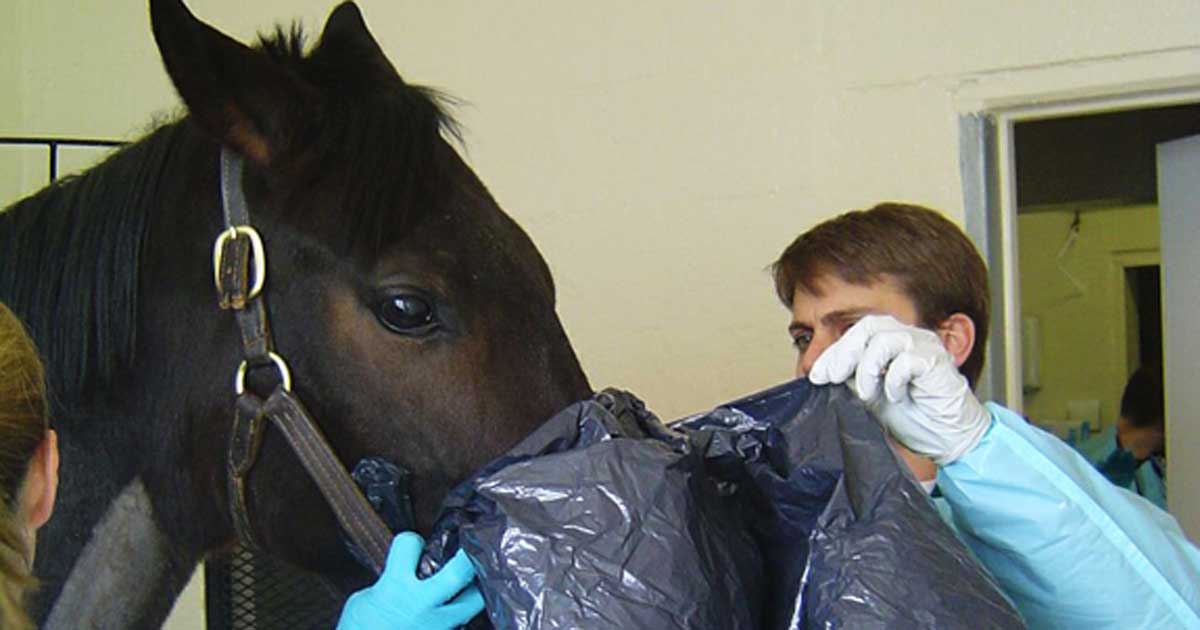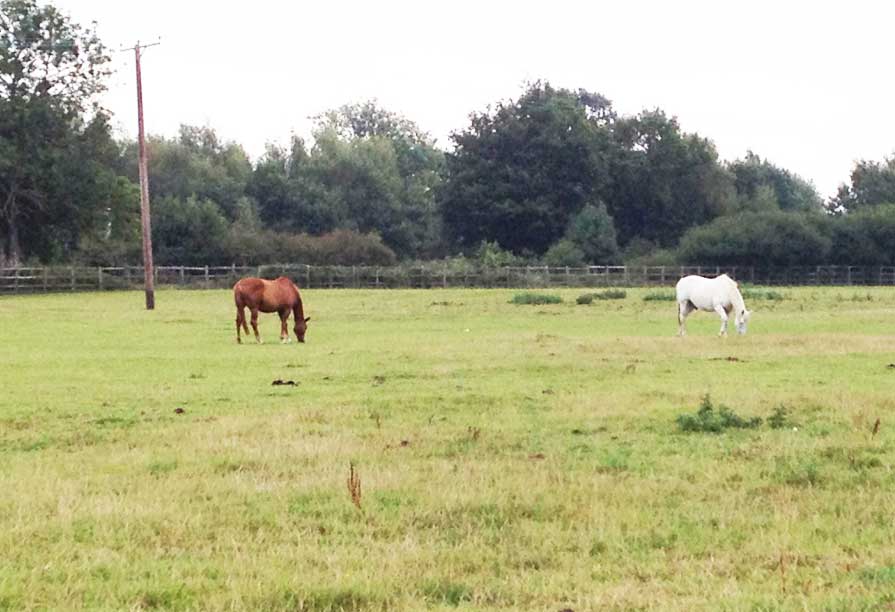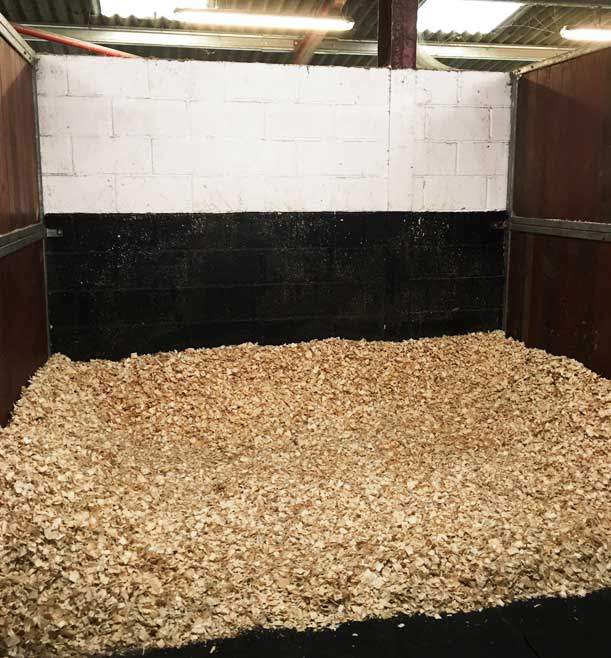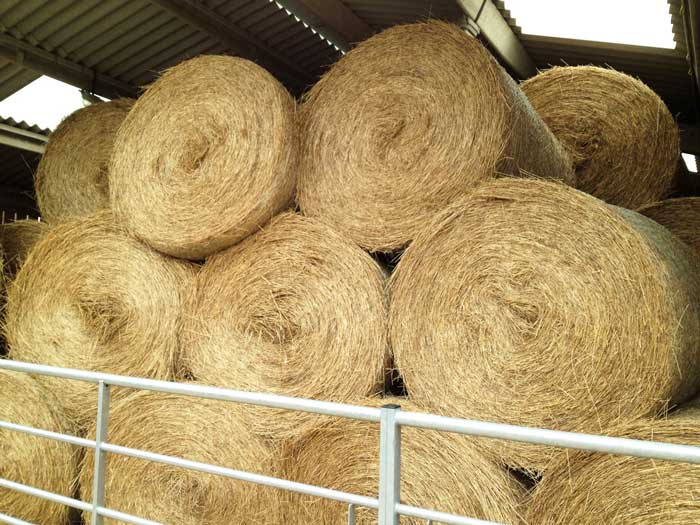12 Nov 2020
Equine asthma – a broad look at problems, causes and treatment
Imogen Johns looks at key aspects of the diagnosis, treatment and long-term control in horses with sEA, as well as newer developments that may be beneficial in the future.

Storage areas for hay and bedding should be a good distance from stables.
Severe equine asthma (sEA) – formerly known as recurrent airway obstruction (RAO) or heaves – is a chronic, performance-limiting – and, in some cases, debilitating – disorder that is characterised by recurrent episodes of airway obstruction following exposure to allergens in dust and mould.
This article summarises what is known about the aetiology, diagnosis and management of the disorder, with the aim of helping clinicians provide the best advice for clients who own asthma-affected horses.
In addition, newer evidence that highlights the importance of ongoing management/treatment, even during periods of clinical remission, will be discussed, as well as alternate or additional medications that may improve management and/or decrease side effects.
New name, same disease?
Just as we finally got used to saying RAO/inflammatory airway disease instead of chronic obstructive pulmonary disease, another new name for the disease was adopted in 20161,2. Has anything changed? Not really. The term equine asthma encompasses the syndromes of non-infectious inflammatory lower airway disease, with subcategories of mild/moderate and severe equine asthma being used to denote disease severity, based predominately on clinical signs.
Although the term is all-encompassing, no evidence exists to suggest a continuum of disease, with a horse suffering from mild/moderate disease progressing inevitably to becoming a horse with sEA.
Mild/moderate equine asthma
- Poor performance with no obvious respiratory signs; airway inflammation detected on bronchoalveolar lavage fluid (BALF) analysis. Other causes of poor performance need to be ruled out, as stabling even “normal” horses can result in an increase in BALF neutrophils (mild disease).
- Clinical signs attributable to the respiratory system present predominately at exercise (cough, increased respiratory rate and effort, abnormal lung auscultation) with increased BALF neutrophilia (moderate disease).
Severe equine asthma
- During disease exacerbations, marked increases in respiratory rate, and effort at rest, cough may be accompanied by “heave line”. BALF neutrophils greater than 20% (severe disease).
This article focuses predominately on the syndrome of sEA; although, in many instances, the treatment and management will be directly transferable to the less severe manifestations of the disorder. Summer pasture-associated asthma is not discussed in detail.
Aetiology and pathogenesis
The syndrome of sEA occurs following exposure to airborne allergens, thought to exist mostly in organic dust and mould, resulting in inflammation, mucus production and bronchoconstriction within the airways. More than 50 types of allergens have been identified in hay and straw dust, and in sEA-predisposed horses, clinical signs develop rapidly following exposure.
Despite, perhaps, the majority of horses being exposed to similar levels of possible antigens, the estimated prevalence of the disorder in horses in the Northern Hemisphere is 14%, suggesting the disorder has a multifactorial aetiology – with a genetic predisposition suspected in some warm blood horses3,4.
Clinical signs and diagnosis
In periods of disease exacerbation, horses with sEA will show laboured breathing (nostril flare, increased thoracic excursion and anal “pumping”), increased respiratory rate and abnormal thoracic auscultation (classically end expiratory wheezes). Some horses will lose significant amounts of weight if the disorder is poorly controlled, presumably due to the increased work of breathing and/or less time spent eating due to the laboured breathing.
During clinical remission, if the disease is well controlled, clinical signs should be absent, although some horses will continue to show signs at exercise (cough or poor exercise tolerance), and abnormal auscultation may persist – especially if a rebreathing bag is used. Horses are typically afebrile, and if a nasal discharge is present, it is mucoid rather than purulent.

Confirmation of the diagnosis should be pursued by endoscopy and cytological evaluation of BALF. If the horse is showing marked respiratory signs, delaying these tests may be sensible, as some horses do not tolerate the procedure well when significant bronchoconstriction is present.
BALF, rather than a tracheal wash aspirate, is preferred, as the disorder is associated with small/distal airway pathology (which is the site sampled during a BALF analysis), rather than a mixed small and large airway sample (tracheal wash). Historically, a poor correlation between tracheal wash and BALF cytology has been shown – and, therefore, when possible, a BALF should be performed5.
The procedure can be performed endoscopically or via a BALF tube, with neither method shown to be superior. A neutrophil count of greater than 20% of BALF cells is considered consistent with a diagnosis of sEA. Some horses during acute exacerbations of sEA will have BALF neutrophil counts that are well below this. This has been termed paucigranulocytic asthma, and is thought to occur because mucus plugs prevent saline withdrawal from the most distal airways, “trapping” the neutrophils6.
Despite marked airway inflammation, systemic (blood) markers of inflammation are typically not raised in horses with sEA. Should these markers be raised and/or the horse is febrile, an infectious respiratory disorder should be suspected, and culture of a percutaneous tracheal aspirate may be warranted.
Equine multinodular pulmonary fibrosis is a rare disorder that can cause clinical signs similar to sEA. Horses can also be intermittently febrile and may have increased inflammatory markers.
The disease is typically diagnosed following lack of response to treatment for suspected sEA and/or bacterial respiratory disease with radiographs, showing a typical nodular pattern.

Treatment
Environmental management
As triggers for sEA are known to exist in hay, straw and associated organic dust, it follows the most effective long-term management strategy is antigen avoidance.
Indeed, horses can be effectively treated and remain in remission with normalisation of BALF neutrophilia, reversal of bronchoconstriction and reduction in airway remodelling (see later) when housed at pasture and fed a pelleted diet. However, for many clients this type of management is not possible or desirable – and, therefore, strategies to reduce dust in the stable environment need to be implemented.
Ideally, all horses that share a breathing space with the affected horse should be treated similarly. Panel 1 highlights some of the key strategies.
Ideal:
- Housed at pasture with pelleted feed if required
If stabling is necessary:
- Ideally the whole barn is managed as a low dust environment
- Maximise turnout
- Ensure horse is housed in best ventilated stable, away from storage areas for hay/bedding and muck heap
- Ensure horses are not in stables when cleaning/sweeping/hay being given
- Dust-free bedding (paper/wood-chip/shavings)
- Pelleted feed
- If long-stem roughage required, feed steam hay/haylage/soaked hay from the floor
- Damp down dusty arenas
- General cleanliness: keep stables clear of mould, dirt
The importance of environmental management cannot be overemphasised, and therapeutic management is unlikely to be successful unless these are undertaken.
In addition to environmental management, supplementation with omega-3 fatty acids may be beneficial.
A study that combined a dust-free environment (dirt paddock and fed a complete pelleted feed) with a supplement containing omega-3 fatty acids showed a significantly greater improvement in clinical signs, lung function and BALF neutrophilia when compared to the horses in the same environment, but without supplementation7. Other anti-inflammatory supplements have been suggested, but, to date, limited or no data supports their use.

Corticosteroids
Corticosteroids (CS) are effective in improving airway function and relieving clinical signs, and systemically administered medications are usually recommended in horses during acute exacerbations.
Dexamethasone given systemically (IV or IM) for a minimum of three days appears to be the most efficacious steroid in terms of rapid resolution of clinical signs and return to normal pulmonary function. Oral dexamethasone can also be used, with the higher dose to account for a bioavailability of approximately 60% (Table 1).
| Table 1. Treatments for severe equine asthma | |||
|---|---|---|---|
| Drug* | Dose | Route of administration | Frequency |
| Dexamethasone sodium phosphate | 0.01mg/kg-0.164mg/kg** | IV/IM/PO | SID |
| Prednisolone | 1mg/kg-2mg/kg | PO | SID |
| Beclomethasone dipropionate | 1µg/kg-5µg/kg (2-10 actuations) | Inhaled | BID |
| Fluticasone propionate | 2µg/kg-4µg/kg (4-8 actuations) | Inhaled | BID |
| Clenbuterol | 0.8µg/kg-3.2µg/kg | IV/PO | BID |
| Salbutamol | 2µg/kg (10 actuations) | Inhaled | q2-4 hours |
| Salmeterol | 0.5µg/kg (10 actuations) | Inhaled | BID |
| Budesonide | 3.5µg/kg (8 actuations) | Inhaled | BID |
| Ciclesonide | 5µg/kg (12 actuations) | Inhaled | BID |
| Salmeterol and fluticasone | 0.2µg/kg-0.4µg/kg 2µg/kg-4µg/kg (4-8 actuations) |
Inhaled | BID |
| Ipratropium bromide | 0.4µg/kg-0.8µg/kg (5-10 actuations) |
Inhaled | q4-6 hours |
| *All inhaled medications are used via the veterinary cascade – and, therefore, informed consent should be sought. | |||
| **Higher doses for PO use. | |||
Oral prednisolone is licensed in the UK for the treatment of respiratory disease in horses and can be effective, although it is a less potent steroid in comparison to dexamethasone (for example, a dose of 0.04mg/kg dexamethasone would be bioequivalent to a prednisolone dose of 2mg/kg) and, therefore, higher doses than those typically used may be necessary to achieve the same response as dexamethasone.
Inhaled CS have been shown to be equally as effective as systemic dexamethasone in treating less severely affected horses, although the response time is typically longer. A recent meta-analysis comparing the effectiveness of systemic versus inhaled CS in horses with sEA showed similar efficacy in improving clinical signs and lung function between the two routes of administration. In practice, it is often more effective, in the author’s experience, to use systemic medications in an acute exacerbation – especially if a horse has not been “trained” to accept the delivery device for the inhaled medications8.
Fluticasone proprionate (FP) and beclomethasone are the most frequently prescribed inhaled CS, and have the advantage of low systemic absorption – and, therefore, possibly decreased side effects. The inhaled medications must be administered using commercially available devices that incorporate a spacer and are placed either across one nostril or fitted as a face mask over both nostrils.
With increasing availability of nebulising devices, interest has been raised into whether CS medications can be effectively delivered to the lower airways by nebulisation. In a recent study, nebulised dexamethasone (5mg IV once a day for seven days) did not result in a significant improvement in clinical score or pulmonary function tests in horses with sEA, despite improvements when the same (low) dose was given orally. As such, this treatment at this dose cannot be recommended for the treatment of horses with exacerbations of sEA9.
The efficacy of two additional inhaled CS – budesonide and ciclesonide – has been investigated10,11. The drugs were delivered via a specially adapted inhalation device using Respimat technology.
Both medications were shown to be effective in providing relief of airway obstruction, with ciclesonide, which is activated in the lungs, having the advantage of resulting in no adrenal suppression. Although the delivery device is not currently commercially available, ciclesonide may be useful in the future for treatment of horses with sEA where systemic CS activity is undesired.

Bronchodilators
In acute exacerbations accompanied by significant increases in respiratory rate and effort, bronchodilation (using atropine, N-butylscopolamine or clenbuterol) can provide immediate, albeit temporary, relief. Longer term, bronchodilators should not be used as a standalone treatment, as they have no anti-inflammatory activity, and tolerance or tachyphylaxis (desensitisation) occurs after 14 to 21 days of treatment12.
Clenbuterol can be a useful drug to help bronchodilate in the short term, while environmental modifications are implemented – especially in horses not treated with CS. Not all horses respond to the drug, with an effect only seen in 75% of horses at the highest recommended dose of 3.2ug/kg.
Long-term management
Once a diagnosis of sEA has been made, and the initial crisis has been managed, a follow-up plan to determine the efficacy of treatment and environmental changes should be made.
Probably because of the various phenotypes that make up the sEA syndrome, horses may respond differently to “standard” therapy – and, therefore, it is important to ensure a good response has occurred, even if a standardised plan has been implemented and has been proven successful in other horses.
A key part of the follow-up evaluations is assessing the environmental modifications and emphasising the importance of maintaining the horse in as low a dust environment as possible, to minimise the need for long-term treatment with CS.
Housing a horse in a low-dust environment (all horses bedded on wood shavings and fed haylage) has been shown to reduce dust concentrations by 86%, and endotoxin concentrations by 95% when compared to a high dust environment (bedded on straw, fed dry hay)13.
In many situations, it is difficult, even impossible, to change the entire barn environment, but even just changing the dust in the breathing zone of the horse, as well as adapting as many environmental modifications as possible, can make a significant difference to the respirable dust concentrations the horse is exposed to.
The efficacy of treatment should be assessed by clinical evaluation and repeat sampling of BALF. Despite resolution of clinical signs, however, airway neutrophilia – and, more importantly, peripheral airway remodelling – often persist during periods of clinical remission, likely contributing to the recurrent and progressive nature of the condition.
Airway remodelling, which occurs in large part due to an increase in airway smooth muscle, is a major contributor to airway narrowing and obstruction, with sEA-affected horses having three times more smooth muscle in their airways than age-matched controls.
Several studies have investigated the potential reversibility of this remodelling14,15. Strict antigen avoidance (horses kept at pasture and fed no hay or haylage) resulted in a 30% decrease in airway smooth muscle across a 12-month period, with a similar result seen in horses treated with inhaled FP for 12 weeks.
These studies highlight the importance of long-term management and follow-up to help maintain optimal airway health in horses with sEA.
Follow-up BALF cytology can be useful in helping assess the efficacy of treatment, but if environmental management is not optimal, a BALF neutrophilia will not normalise – despite treatment with CS – even for as long as six months.
As such, persistence of airway inflammation (neutrophils greater than 10% in BALF) after several months of treatment/management suggests further environmental changes should be investigated. If further modifications are not possible, consideration should be given to long-term inhaled CS to help minimise further airway remodelling and narrowing.
No significant immune suppression was observed in horses treated with FP for longer than six months, and importantly the antibody response after vaccination was not affected, suggesting long-term treatment is associated with few, if any, side effects16.
Future directions
While currently available medications and environmental management can be very effective in treating horses with sEA, they are labour intensive, may be associated with side effects and, in some cases, client compliance is suboptimal. As such, newer treatments and strategies are being developed in an attempt to overcome some of these impediments to effective treatment.
One of the new treatments is the use of cytosine-phosphate-guanine oligodeoxynucleotides (CpG-ODNs), which are molecules that direct the immune system towards a cell-mediated T helper type 1 pathway and away from the pro-allergic humoral T helper type 2 response, which is thought to dominate in horses with sEA.
The CpG-ODN is delivered by inhalation, and a 2015 study resulted in a significant improvement in clinical and laboratory findings when compared to untreated horses, with the positive effect persisting for up to several weeks following discontinuation of treatment17. A follow-up study confirmed these results, with the effect similar to inhaled beclomethasone, suggesting inhaled CpG-ODN may be useful for the long-term treatment of horses with sEA18.
Conclusion
Although the diagnosis of sEA is usually relatively easily obtained in affected horses, treatment – and, in particular, long-term management – can be challenging for a variety of reasons.
The mainstay of therapy will always be antigen avoidance, but in cases where this is impossible, the use of CS is indicated.
This may pose a problem in horses in which CS are thought to be contraindicated, or at least the risks of adverse effects are greater. In these horses, long-term β-2 agonists should not be used, as they have no anti-inflammatory ability, their efficacy will decline within two to three weeks due to tachyphylaxis, and they provide only symptomatic relief.
CS that have little or no systemic action may soon be available to use, and non-steroidal medications that aim to divert the immune system away from the pro-allergenic state may also be available. As we learn more about the triggers for asthma and the different phenotypes, more directed therapy may also be possible.
References
- Couëtil LL et al (2016). ACVIM Consensus Statement: Inflammatory Airway Disease of Horses – Revised Consensus Statement, J Vet Intern Med 30(2): 503-515.
- Bond S et al (2018). Equine asthma: integrative biologic relevance of a recently proposed nomenclature, J Vet Intern Med 32(6): 2,088-2,098.
- Hotchkiss JW et al (2007). A survey of horses in Great Britain regarding horses in their care. Part 2: risk factors for recurrent airway obstruction, Equine Vet J 39(4): 301-308.
- Mason VC et al (2018). eQTL discovery and their association with severe equine asthma in European Warmblood horses, BMC Genomics 19: 581.
- Pirie RS (2014). Recurrent airway obstruction: a review, Equine Vet J 46(3): 276-288.
- Bullone M and Lavoie JP (2017). Science in brief: equine asthma diagnosis: beyond bronchoalveolar lavage fluid cytology, Equine Vet J 49(3): 263-265.
- Nogradi N et al (2015). Omega-3 fatty acid supplementation provides an additional benefit to a low-dust diet in the management of horses with chronic lower airway inflammatory disease, J Vet Intern Med 29(1): 299-306.
- Calzetta L et al (2018). Clinical effect of corticosteroids in asthma-affected horses: a quantitative synthesis, Equine Vet J 50(5): 594-601.
- Mainguy-Seers S et al (2019). Nebulisation of dexamethasone sodium phosphate for the treatment of severe asthmatic horses, Equine Vet J 51(5): 641-645.
- Lavoie JP et al (2019). Efficacy of inhaled budesonide for treatment of severe equine asthma, Equine Vet J 51(3): 401-407.
- Lavoie JP et al (2019). Effect of different doses of inhaled ciclesonide on lung function, clinical signs related to airflow limitation and serum cortisol levels in horses with experimentally induced mild to severe airway obstruction, Equine Vet J 51(6): 779-786.
- Read JR et al (2012). Effect of prolonged administration of clenbuterol on airway reactivity and sweating in horses with inflammatory airway disease, Am J Vet Res 73(1): 140-145.
- Siegers EW et al (2018). Effect of ionization, bedding, and feeding on air quality in a horse stable, J Vet Intern Med 32(3): 1,234-1,240.
- Bullone M et al (2017). Fluticasone/salmeterol reduces remodelling and neutrophilic inflammation in severe equine asthma, Sci Rep 7: 8,843.
- Leclere M et al (2012). Corticosteroids and antigen avoidance decrease airway smooth muscle mass in an equine asthma model, Am J Respir Cell Mol Biol 47(5): 589-596.
- Dauvillier J et al (2011). Effect of long-term fluticasone treatment on immune function in horses with heaves, J Vet Intern Med 25(3): 549-557.
- Klier J et al (2015). Nanoparticulate CpG immunotherapy in RAO-affected horses: phase I and IIa study, J Vet Intern Med 29(1): 286-293.
- Klier J et al (2019). Immunomodulatory asthma therapy in the equine animal model: a dose-response study and evaluation of a long-term effect, Immun Inflamm Dis 7(3): 130-149.
